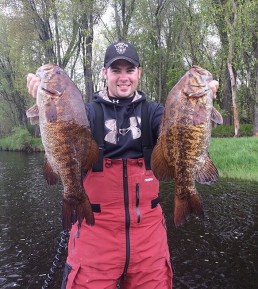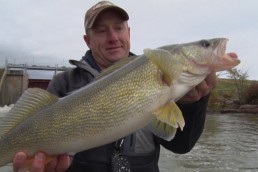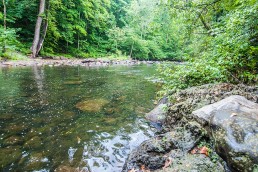On the Jets with Wisconsin River Smallmouths
SHARE THIS POST
The Wisconsin River is well known for producing abundant, under-fished populations of trophy smallmouth bass. As it begins at its headwaters of Lac Vieux Desert on Michigan’s U.P. border—resembling more of a large creek that winds its way through the wild northern reaches of Wisconsin—the character of the river changes considerably the farther downstream it’s traveled.
The Wisconsin River is a boating and wade-fishing minefield. It’s a paradise for river smallmouths, but pending death grounds for boats. Anglers willing to accept its challenging terrain and difficult navigation don’t mind.
With treacherous navigation present, rugged jon boats powered with jet drive outboards are the most ideal watercraft for most Wisconsin River angling. Kurt Schultz, Brokaw, Wis. resident and licensed fishing guide, best exemplifies this adaptation to fish and annually succeeds on these treacherous waters where few are able to do so with regularity.
Schultz, 35, has been a licensed fishing guide on the central regions of the Wisconsin River since 1999. His passion for the Wisconsin River fishery began a boy growing up in the 1980s, where he spent nearly every free hour on the river learning the trades of someday becoming a river rat and making a living from its resources. Today, Schultz runs over 180 guide trips per season, specializing in muskies, bass, pike, walleyes and panfish.
Schultz is better known as a muskie fishing guide, however, he openly admits to having a fiery passion for big river smallmouths, which is the best game in town from spring through midsummer.
The Wisconsin River fishery
The allure of smallmouth here is the result of natural river habitat that hasn’t been influenced or degraded. Combined with little fishing pressure and difficult-to-navigate miles of river that isn’t floated by boat or fished often, an amazing bass fishery sustains itself.
I joined Schultz on a mid-May morning and afternoon in the central Wisconsin region, on a stretch of pristine river comprised of rock fields and boulders, islands and oxbows and logjams. It was an ideal wilderness setting.
We fished in the midst of the spring-spawning period, as water temperatures were 56 to 60 degrees. We both knew that when located, these fish would be concentrated in the spawning areas.
“There is an abundant population of smallmouths in the Wisconsin River, from where it begins in northern Vilas County, all the way south to the confluence of the Mississippi River,” says Schultz. During spring, the population density shows, as do numbers of bigger fish. As the spawning season progresses into the post-spawn and summer phase, fish disperse and the game grows tougher.
“At this time, in midsummer, fish are more scattered. There are certain stretches that will hold a lot of bass, but there’s a lot of dead water in between. Big bass can be caught all throughout summer and into fall, but the key at this time is to cover water and work as many different spots as you can.”
During our eight hours of fishing together, floating 5 miles of river, and learning from one another as fellow river rats, Schultz and I had a good day of fishing despite facing post-frontal conditions and a pending cold front. Approximately 30 smallmouths were boated with average size recorded at 18 inches, with the largest being a handful of specimens up to 20 1/2.
Is this good enough to be considered a world-class inland fishery?
According to Schultz, whose largest Wisconsin River smallmouth to date is a 6.2-pounder measured at 22 1/4 inches, “A great day of fishing the river can produce up to 40 to 50 bass, ranging from 14 to 21 inches.”
These high catch rates are most common in spring as fish are migrating upstream and holding in the river, and then again in autumn as fish begin schooling together in their downstream wintering holes located in the flowages. Meanwhile, a tougher day of fishing can yield 10 to 15 of similar size.
Schultz admits that if you are new to the Wisconsin River, your first few outings may be trying times.
“Every minute you spend on the river, whether catching bass or simply navigating it, you should be learning things,” he says.
What sets Schultz apart from most river anglers is his ability to process information and retain the knowledge learned from over 20 years of river fishing experience.
Are you enjoying this post?
You can be among the first to get the latest info on where to go, what to use and how to use it!
“I have become a great river angler because of all the times I’ve spent on this water, catching nothing,” he says.
When Schultz catches fish, he analyzes how it was caught and why it struck his lure. This enables him to figure out their patterns and find their locations.
Locations and river movements
The Wisconsin River is ready for bass fishing as soon as the ice flows melt away in April, and bass migrate from their wintering holes into the main stems of the river for feeding followed by spawning. “Bass will travel up to 15 miles or more, and I’ve witnessed this,” Schultz says.
“The smallmouth bass spawn, like most other river species, is different in every pool of the Wisconsin River. I’ve observed the spawning period start as early as mid-April, and some years it doesn’t happen until late May or early June. It all has to do with the climate, weather patterns, stream flow rates and water temperatures,” he concludes.
Schultz follows a springtime biological calendar, and applies it for his decision-making and execution. Each spring season differs, thus, the key to any spring smallmouth movement and the trigger for spawning, all correlates to the ice-out schedule and climbing water temperatures.
Due to ice jams, current, and water level fluctuations, the channels and depths of pools are always changing. Thus, there aren’t any suitable navigational maps for the Wisconsin River to aid anglers in locating spots. The process of finding fish is a hands-on approach for Schultz, as he uses his Humminbird 898 with side imaging to find underwater structure and his eyesight and visual cues for identifying and reading the river.
“I will spend hours driving upstream and downstream, through the channel and along shorelines, marking depths and adding waypoints onto my LakeMaster GPS chart,” he says. “It is best to do mapping in spring when weed growth is down, so the bottom can be marked clearly. If you are not equipped with a locator, the next best thing is to look for trees along the shore that have fallen in, or rocky shorelines, as they will extend into the channel, and (indicating) the presence of rusty crayfish. See them onshore; bass are not far away!”
The process of locating and catching river smallmouths relates to their habitats, migrations and the angler’s ability to determine good locations.
“When I go out and search for smallmouths, I cover as much water as I can each day,” says Schultz. A typical daily float for Schultz and his clients will run anywhere between 2 to 6 stream miles. “Once I locate one bass, I know a ‘wolf pack’ of others will be nearby,” he says, with a sly smile.
In order to approach the fish in spring, Schultz and his clients will start the season in the vicinity of spawning sites, looking for shallow, calmer hard-bottom waters in depths ranging from 3 to 10 feet. Such areas are stumps, shoreline pockets, mid-river eddies, the downstream pools of islands and oxbows and current breaks that include boulders and logjams.
“We usually position a long distance from shore, bombing long casts to reach these fish,” he says. Once fish conclude with spawning and disperse throughout the river, covering water with search baits is the way to go. If good structure and habitat is located and fished in summer, you will find bass on the Wisconsin Schultz says.
Kurt Schultz can be reached by telephone at 715-571-7132, by email at ksguiding@gmail.com and online at kurtsguiding.net.
For more information…
To schedule a trip with Kurt Schultz, it’s best to inquire 2 to 4 weeks in advance to request a desired date to fish with him. Not only will anglers catch fish with Schultz, but you will also learn about river fishing strategies and how to fish the Wisconsin River.
MWO
SHARE THIS POST
Did you enjoy this post?
You can be among the first to get the latest info on where to go, what to use and how to use it!
Andrew Ragas
Andrew Ragas splits time between Chicago and Wisconsin’s Northwoods. Based in Minocqua, Wis., he specializes in trophy bass fishing and offers guided trips from May through October. While big bass are his passion, he dabbles in multispecies, as well. He may be visited online at northwoodsbass.com



